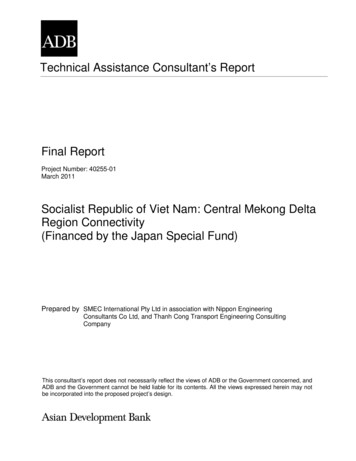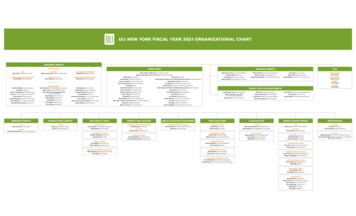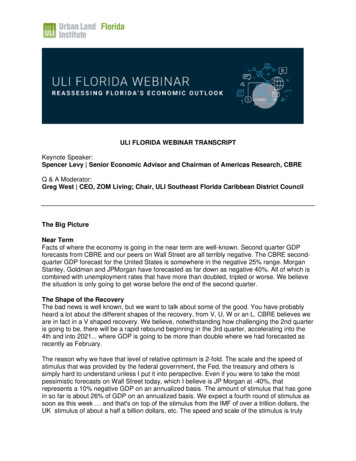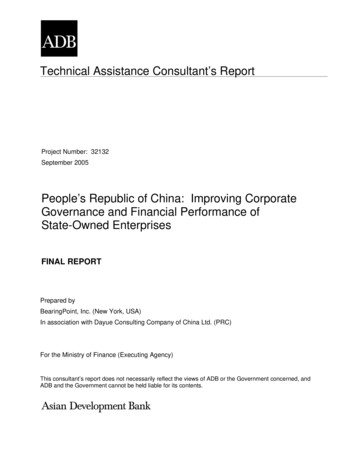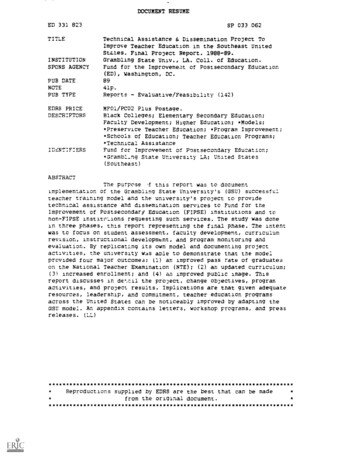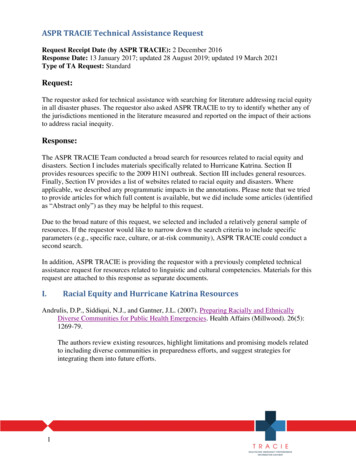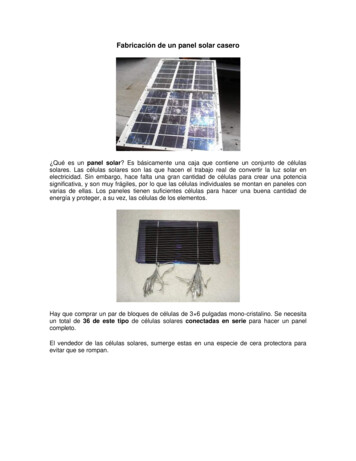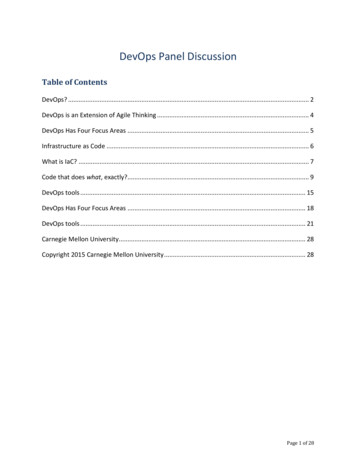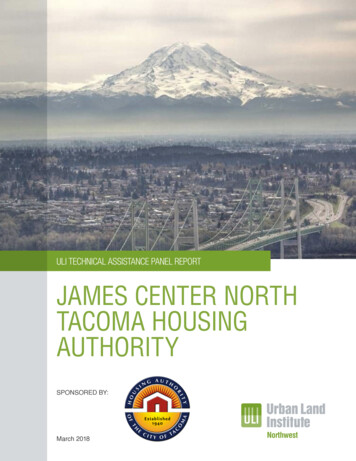
Transcription
ULI TECHNICAL ASSISTANCE PANEL REPORTJAMES CENTER NORTHTACOMA HOUSINGAUTHORITYSPONSORED BY:March 2018Northwest
ABOUT ULI NORTHWESTULI Northwest is a District Council of the Urban Land Institute (ULI), a non-profit education and research organization supported by its members.Founded in 1936, the Institute today has more than 44,000 membersworldwide. ULI members represent the full spectrum of land use planning andreal estate development disciplines working in the private, public, and nonprofit sectors.ULI’s mission is to provide leadership in the responsible use of land and increating and sustaining thriving communities worldwide. ULI Northwest carriesout the ULI mission locally by serving as the preeminent real estate forum inthe Pacific Northwest, facilitating the open exchange of ideas, information,and experiences among local, national, and international industry leaders andpolicy makers.Our mission is to: Build a regional vision of the Northwest that embraces and acts upon Encourage the collaboration among all domains—public and private—of quality growth principles.the real estate industry.Build consensus among industry and public leaders who influence landuse, transportation, environmental, and economic development policies.Contact UsNorthwestULI Northwest107 Spring StreetSeattle, WA g 2018
ABOUT THE TECHNICAL ASSISTANCE PANEL (TAP) PROGRAMThe objective of ULI Northwest’s Technical Assistance Panel (TAP) Programis to provide expert, multidisciplinary, and non-partisan advice on land useand real estate issues facing public agencies and non-profit organizationsin the Pacific Northwest. Drawing from its extensive membership base, ULINorthwest conducts multi-day panels offering objective and pragmatic adviceto local decision makers on a variety of land use and real estate issues,ranging from site-specific projects to public policy questions. The TAPProgram is intentionally flexible to provide a customized approach to specificland use and real estate issues.Learn more at: https://northwest.uli.org
Table of ContentsPANELISTS1STAKEHOLDERS & PROJECT STAFF2ACKNOWLEDGMENTS3EXECUTIVE ENDUM17Panel representativesfor the Tacoma HousingAuthority TAPT E C H N I C A L A S SI S TA N C E PA N E L R E P O R T
PanelistsAl Levine, Panel ChairFaculty, University ofWashington Runstad CenterArun JainUrban Designer/Urban StrategistKate JoncasOwner, PlaceStrategicConsultingAlison LorigSenior Vice President,Pacific Northwest,Bridge HousingChris MeffordPresident, CommunityAttributesHeidi OienPrincipal, MithunBrian SullivanPrincipal, Community Housing ConsultingMike WooReal Estate DevelopmentManager, VulcanJ A M E S C E N T E R N O R T H TA C O M A H O U SI N G A U T H O R I T Y1
Stakeholders& Project StaffSTAKEHOLDERSTacoma Housing AuthorityMichael Mirra, Executive DirectorApril Black, Deputy Executive DirectorSandy Burgess, Director ofAdministration ServicesFrankie Johnson, Director of PropertyManagementKathy McCormick, Director of RealEstate DevelopmentKen Shalik, Director of FinanceReal Estate Development Dept:Emily Casebeer, InternJosh Jorgensen, Project ManagerKaren Peterson, Department ManagerRoberta Schur, CommunityDevelopment ManagerDerek Young, Board CommissionerColdwell Banker DanforthBob Fredrickson, PresidentKim Adams, BrokerEnterpriseJon Clarke, Loan OversightJames Madden, Loan OversightFirst Western PropertiesBlake Weber, BrokerHelix Design Group IncMatt Ebersole, ArchitectMission Rock ResidentialMelanie Miller, Assistant PropertyManagerPierce TransitMax Henkle, Senior PlannerSound TransitTim Bates, Senior Land Use PlannerChelsea Levy, Government andCommunity Relations OfficerTacoma Community CollegeGregory Randall, Director, Facilities:Administration and Capital ProjectsWashington State Housing FinanceCommissionBob Peterson, Manager, MultifamilyHousing and Community FacilitiesDivisionPROJECT STAFFULI NorthwestKelly Mann, ULI NorthwestAlex Holtze, UW Runstad CenterMelony Pederson, UW Runstad Center2T E C H N I C A L A S SI S TA N C E PA N E L R E P O R TREPORT AUTHORClair Enlow
AcknowledgmentsULI Northwest is grateful to the Tacoma Housing Authority for its commitmentto make this TAP a productive and successful experience. The engagementand desire for attractive and equitable mixed use and mixed incomeneighborhood is reflected in this report. ULI is thankful to Joshua Jorgensen,Kathy McCormick, Roberta Schur and Emily Casebeer who managed theprogram logistics and coordinated the stakeholders and staff who providedvaluable input for this report.J A M E S C E N T E R N O R T H TA C O M A H O U SI N G A U T H O R I T Y3
Executive SummaryThe Tacoma Housing Authority (THA) is to be commended for seizing theopportunity to oversee growth of a high-quality mixed income communitydirectly across from Tacoma Community College, and within easy walkingdistance of present and future regional transportation. THA has earned areputation for well-planned and well-managed communities, and should bewelcomed as a partner in transformative neighborhood development.The nearly seven-acre James Center North site, located in West Tacoma, isnow a combination of 1980s retail and office structures and paved parking.This area is well positioned to become a vibrant mixed-use neighborhood. Inaddition to affordable housing for families, seniors, and students, the site cansupport amenities and community resources that bring value to neighboringparcels. All of this should be based on planning for change, formingpartnerships, developing a long-term strategy, and supporting long-term goalswith a short-term strategy.Investment in the James Center North site will be enhanced through a long-termapproach to development, and through planning for a sustainable, walkablecommunity that is oriented toward the future and not bound by the past.Planning for change. The type of housing construction that is desirable,marketable, and even permissible—especially in an urban environment—ischanging. Staged development and flexible planning will allow THA and itsplanning partners to take advantage of important trends.Forming partnerships. With its positive track record and long-terminvestment, THA has a tremendous opportunity to position itself as a reliablepartner in the development of a vibrant urban neighborhood. New leaders atTacoma Community College (TCC) and owners of James Center are potentialpartners, and THA should familiarize itself with their long-range goals andaspirations as soon as possible. The involvement of the city of Tacoma in themaster plan will be essential, and the city should be contacted at the outset ofthe process. A partnership between THA and James Center, with involvementof TCC, could spur more support from the city in the form of facilitatedplanning, permitting, and infrastructure investment. THA’s challenge is tocreate and sell a vision and its value to adjacent property owners.4T E C H N I C A L A S SI S TA N C E PA N E L R E P O R T
Developing a long-term strategy. Realizing the full potential of the JamesCenter North site means raising expectations and adapting short-termplans to support long-term development. A 20-year horizon allows time fora collaborative planning process coupling quality design with pedestrianinfrastructure. The highest and best use for the site will include corridors forpeople to safely walk and bike and supports sustainable drainage systemsand attractive landscaping. It would be appropriate to produce a master planwithin the next three years. While the plan should include a timeline for phaseddevelopment, it should also be flexible and adaptable. Criteria and standards,agreed between owner and developer partners, could be included.Supporting long-term goals with a short-term strategy. In the short term,THA should make modest upgrades to generate reliable, adequate income forplanning costs and debt service. This is likely to include tenant improvementsfor flexible office space or workforce development, with limited investmentand possibly build-to-suit partnership. The master plan should include someshort-term steps, including construction of affordable housing in a multi-familyproject on all or part of the former C&D Lounge footprint.Bay Terrace is a Tacoma Housing Authority multi-family project that houses familiesJ A M E S C E N T E R N O R T H TA C O M A H O U SI N G A U T H O R I T Y5
BackgroundTacoma Housing Authority develops and manages high-quality mixed-incomecommunities that include low-income families, seniors and people withdisabilities. THA owns or holds interest in seven family properties, eight senior/disabled properties, and three commercial properties in Tacoma; this does notinclude properties that are under development or in the pipeline. Most of theproperties are self-managed. All but one property, Salishan, have been addedto the THA portfolio since its founding in 1940. Salishan was part of a 225million HOPE VI redevelopment.Examples of differenttypes of THA propertiesAccording to the agency’s mission statement, THA’s goal is to help peoplesucceed, as tenants and as parents, students, wage earners, and builders6T E C H N I C A L A S SI S TA N C E PA N E L R E P O R T
of assets. To that end, the agency couples housing with supportive services.THA currently manages communities in nine distinct neighborhoods. Untilrecent acquisitions such as James Center North, West Tacoma was underrepresented in the THA portfolio.“THA has a really good reputation in town.”THA purchased James Center North in October 2017 for slightly under 6million. The 6.92-acre commercial site includes over 62,000 square feet ofbuilding space in total, most built in 1985. Four commercial structures currentlyoccupy the site, including restaurant, medical and retail buildings.Aerial of James CenterNorth facing southwestShort-term financing for the purchase is a 4 million REDI Loan from EnterpriseCommunity Loan Fund. The terms are that THA will repay 1 million by 2021and an additional 3 million by 2023. Mid-term financing includes a 2 millionLAP Loan from Washington State Housing Finance Commission. It obligatesTHA to place affordable units in service by 2025, at which time the loanbalance is due.James Center North is across from Tacoma Community College (TCC), acommuter college offering 46 professional and technical degree programs.The student population of TCC, one of 34 community colleges in the stateof Washington, exceeds 14,000. Enrollment tends to rise and fall in inverserelationship to employment trends. Since employment is currently rising, TCCis likely to see an increase in the proportion of foreign students, along withincreased need for nearby student housing.J A M E S C E N T E R N O R T H TA C O M A H O U SI N G A U T H O R I T Y7
Adjacent to James Center North, between the site and the future Sound Transitstation, is James Center, a 128,000-square-foot retail center anchored by afull-service grocery store, Fred Meyer. Other tenants include Rite Aid, Fed EX,Chase Bank, Starbucks, and IHOP.Across from James Center and adjacent to TCC is Pierce Transit’s TCC TransitCenter, a city-wide hub serving nine bus routes with about 2,000 peopleboarding each weekday. Living within a three-mile radius is a population ofmore than 100,000, many in single-family homes. The average householdincome in the area is over 76,000.The site is roughly square, at up to 600 feet on each side. It slopes from westto east, toward South Mildred Street and TCC, making it very visible from thecollege campus.The zoning designation for the site is Community Commercial Mixed-UseDevelopment. The most prominent street frontage of the site is along SouthMildred Street, a thoroughfare that passes between James Center North andTacoma Community College. It has been designated by the city of Tacoma forenhancements as a pedestrian-friendly multi-modal corridor. A private streetlying along the north side of the parcel and perpendicular to South MildredStreet is planted with mature trees. Rockeries of up to four feet high lie alongthe east and south property lines.“8T E C H N I C A L A S SI S TA N C E PA N E L R E P O R TWe want to make it ‘lovely.’”
RecommendationsWith the James Center North site, Tacoma Housing Authority has a goldenopportunity to help shape a West Tacoma future that is safe, vibrant,prosperous, attractive and equitable.“People in Tacoma get that density is needed.”As it adds housing choices, the agency has a unique opportunity to supportthe development of a walkable and sustainable neighborhood, all neartransit and education. Such a plan is likely to win city support becauseit would leverage other public investments in the neighborhood. With arapidly changing regional real estate environment and local leasing markets,THA should invest in a flexible, long-term plan and two-stage strategy fordevelopment of the site. The best plan will support long-term goals as wellas short-term leasing and management. This type of plan supports privatedevelopers who are responding to an evolving market. It includes somedetailed decisions (mostly involving infrastructure) that are to be implementedfirst, and leaves many others (such as program and architecture) for later.“What do we want to be when we grow up?Plan for change”The purchase of James Center North comes at a time when residential, retail,and office markets are undergoing rapid change, especially in urban areas. Amaster plan will allow THA and partners to take advantage of some or all thefollowing trends:Housing. Now and in the years ahead, increases in shared housing and multi-generational living are expected. THA should be on the watch for design anddevelopment experiments involving shared amenities and interactive spaces.These could inform the design of affordable housing. Housing for seniorsis also changing to become more integrated with urban communities andyoun
James Center North is across from Tacoma Community College (TCC), a commuter college offering 46 professional and technical degree programs. The student population of TCC, one of 34 community colleges in the state of Washington, exceeds 14,000. Enrollment tends to rise and fall in inverse relationship to employment trends. Since employment is .
